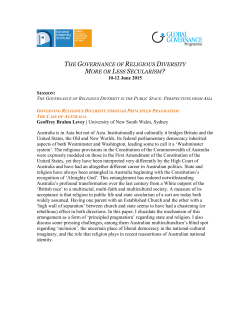
Grasstrees Australia
YOUR REGULAR GARDENING NEWS FROM NEUTROG AUTUMN 2015 Grasstrees Australia Considering building a veggie garden? In development Bush Tucker An Australian Native Plant Fertiliser Saving Australian grasstrees (Xanthorrhoea Preissii) and Zamia palms (Macrozamia Riedlei). Introducing Gallipoli Centenary Roses Image supplied by Treloar Roses Patlin Gardens perfect produce next Patlin Gardens Patlin Gardens situated on the Gawler River, north of Adelaide, supply restaurants around South Australia with their fresh vegetables and authentically preserved olives and olive oil. Head chefs of award winning prev restaurants such as Chianti Classico personally select their seasonal produce each week direct, knowing that it is one of the key factors to their success. Other users are Windy Point Restaurant, in particular for their infamous olives and olive oil, The Adelaide Convention Centre, Art Gallery of South Australia and Adelaide Oval for specific functions and events. provide these. Although still popular at the markets Pat and Lina are very aware that as the unusual becomes mainstream, chefs will look for something unique to add to their menus. They thrive on the challenge and are always looking to keep up with new demands and culinary ideas. Over the last couple of seasons baby fennel, chicory leaves and even stinging nettle have been surprisingly popular requests. The olives at Patlin Gardens are harvested and naturally fermented in the traditional Italian way over several months. This method results in olives with a richer taste, as the widely accepted and shorter chemical treatment process tends to disguise the true taste of the olives. Olive Oil is also pressed and bottled after the winter harvest. Pat D’Onofrio and Lina Verilli are the business owners and growers at Patlin Gardens. Whilst their reputation has grown amongst key Adelaide restaurateurs and patrons, they have continued to service their loyal weekly customers selling direct to both chefs and home cooks at the Adelaide Farmers Market, Wayville Showgrounds. On the 20 acre market garden Pat and Lina grow their pesticide and chemical free vegetables in rows between the 1200 olive trees. Fed by Rapid Raiser for the past 20 years the soil is brimming with life and organic matter - the secret to their success. Vegetable varieties are selected with taste and colour in mind - there are 20 heirloom varieties including some they grew up with in Italy - 100 overall. Pat and Lina are always sourcing and trialling new varieties of seeds that suit the growing conditions, and educating and encouraging their customers to try vegetables that they are not familiar with. The sweet tasting golden beetroot is one of their most soughtafter veggies, being one of the first growers in South Australia to Over the years Patlin Gardens have popped up in food and travel guides and SBS TV show Italian Food Safari. This year they are looking forward to featuring in a new series about Australian Food Adventures on UK’s Channel 4 with Jimmy Doherty. Most of all Pat and Lina look forward to a year continuing to delight their customers with quality seasonal produce. next From The Ground Up TIP: Considering a veggie garden? Home grown fruit and vegetables taste better and fresher because they can be harvested at the peak of maturity with full flavour. Raised beds are an easy project and can be put together to suit your available space. are relatively cheap. There is no need to tie them into place - place them next to each other in whatever shape that fits and fill up with soil, ensuring to tamp it down to avoid the soil level falling part way through the season. Straw will last one growing season, and then can be used as mulch or added to your compost system. Getting Started: Prepare soil well ahead of planting by adding compost, Seamungus and manure. Most vegetables, herbs and fruit trees need full sun and well-drained soil. Design your garden with this in mind and for ease of access. Draw it on graph paper and ensure space between sections for a wheelbarrow. prev Now simply allow a little time each day to work in your new vegetable garden! Try these at the Online Store Garden bed Construction: Retaining walls built around your vegetable beds have many benefits - they increase soil depth, facilitate soil drainage and give you a seat for planting and tending. Don’t skimp on size though…big beds are best but make sure you can reach all parts of the bed. Pathways should have a hard surface of gravel or paving. A little gravel placed in the bottom of each bed helps with drainage too. Build raised beds to a height of 400 – 500mm. Here are some choices: Timber sleepers are long-lived and hard wearing. They are secured together with long 150mm screws through into short corner posts. Look for safe, family-friendly timber from your landscape yard that hasn’t been treated with chemicals. 100% Organic Sample Pack Water tank beds are movable and lightweight, and are good for rental properties as they are portable. They give a great ‘country’ look and are available in round or slimline shapes and in different heights. Besser blocks, two high and mortared into place will result in a wall 400mm high. Make a coping course of common brick where you can sit to plant. Render the exterior with ochre-coloured sand included into the mix to achieve a finished result. The interior wall should be sealed to prevent water seeping into the brick and ruining the exterior finish. Drainage holes should be made in the mortar while it is wet. Straw bales make good retaining walls for your veggie plot. They are wide enough to sit on as you plant and harvest, and The four products in our Organic Sample Pack are perfect for veggies, herbs and fruits such as berries. Pack includes Rocket Fuel, Seamungus, GOGO Juice and Seamungus Liquid Concentrate. Available at the online store next Grasstrees Australia prev Recent major projects have included the Fiona Stanley Hospital and Joondalup Health Campus, and currently they are nurturing many trees that will be replanted mid 2015 as part of the Gateway WA Perth Airport and Freight Access Project – Perth’s biggest ever infrastructure project. As more people are discovering the tranquillity of country living in and around the outer edges of Perth’s hills and surrounding bushland, extra land is being cleared for rural living and associated services. Some of the casualties of clearing for development have been the unique Australian grasstrees (Xanthorrhoea Preissii) and Zamia palms (Macrozamia Riedlei). Many of these plants are hundreds of years old and one business has taken on the challenge of rescuing this precious resource. Established for 20 years, Grasstrees Australia rescue the endangered Western Australian native Grasstrees and Zamia palms under licence from the Department of Parks and Wildlife. Once extracted from their natural habitat, the plants are transported to the four hectare nursery at Wattle Grove where they are nurtured for 12 – 18 months. This process, perfected over many years, ensures the plants are nursed through their transplant shock phase and develop a healthy new root system prior to relocation. In an interesting turnaround, a number of the rescued trees are replanted in their original environment where they were first rescued from, as developers incorporate the native plantings back into their development plans. The remainder are supplied to the public, government projects, land and property developers, local councils, nurseries, and the interstate and international export market. For the past 5 years the work of Grasstrees Australia has been overseen by Justin and Leanne Leeder along with sons Tom and Harrison. Passionate about the difference they are making to the Perth landscape they are extremely proud to be part of the preservation of these native flora treasures for future generations to enjoy. Over the past three years the business has been recognised as finalists in the Landscape Industries Association Awards of Excellence, Western Australian Environmental Awards and the Nursery and Garden Industries Awards. The experienced team at Grasstrees Australia are best known for their high transplant success rate. Since trials in 2011, Seamungus has become the major element in the development of new root systems in the nursery stage and the installation process. Leanne said, “After testing Seamungus extensively in the nursery facility the results gave us the confidence to use it on a commercial basis and to recommend Seamungus to our retail clients for ongoing fertilisation of their grasstrees during establishment.” The grasstrees and palms have strong green foliage heads and healthy root systems ensuring a higher rate of transplant success, critical to the reputation of the business and ongoing commercial contracts. For more information on these unique recycled trees or to visit the retail and display nursery go to www.grasstrees.com.au next Gallipoli Centenary Roses It seems that word of mouth is how gardeners get the best tips. In Port Elliott in SA one recommendation led to another between neighbours leading to this gardener applying Sudden Impact for Lawns to one section of his front lawn and his usual fertiliser to the remainder. The photo speaks for itself – what a difference! Both lawn areas are the same lawn type and have received the same amount of water. Soon the whole street will be using it! Treloar Roses, in conjunction with the ANZAC Day Commemoration Committee (Qld) Inc, have introduced the Gallipoli Centenary Rose to commemorate the ANZAC Gallipoli Centenary in 2015. Sales of this rose will raise funds for projects to honour all ANZACS and Australians who have served their country in times of conflict. prev Director of Treloar Roses, Gary Matuschka said, “We are truly honoured to be releasing this special rose to signify the centenary of the ANZAC landings at Gallipoli. This rose not only looks beautiful, it has won numerous awards in Australia and overseas for disease tolerance and hardiness, making it a tremendous choice to be named for this important occasion of national remembrance.” The official launch of the Gallipoli Centenary Rose will take place at the Melbourne International Flower and Garden Show this month and will be available in early June. Pre-order now through Treloar Roses www.treloarroses.com.au or inquire at your local nursery. Ross Roses in South Australia have also released a stunning red rose to commemorate the ANZAC landing in 1915. The Spirit of Gallipoli has been bred by Andrew Ross and extensively trialled over the past five years. The rich red hybrid tea rose is free flowering and sun hardy. Available from July by mail order or direct from Ross Roses at Willunga. Mailbox Image supplied by Treloar Roses Rose Name: Gallipoli Centenary Rose Breeder: W. Kordes’ Sons Breeder Code: Kortutu Category: Modern Shrub Bush Rose Colour: Deep red Size: 1.2m tall x 80 cm wide Description: Created by world renowned rose breeders, Kordes of Germany, it has all the exceptional health and hardiness that their varieties are famous for. The large, elegant blooms are a stable deep red, appearing in clusters and also one to a stem. The dense bush is adorned with lush deep green foliage and will grow to around 1.2m tall. This variety has been decorated with a Gold Medal in international awards, along with ‘Best Shrub’ and a Bronze Medal at the National Rose Trial Garden of Australia. Autumn is the perfect season to improve your lawn areas. Gardening presenter Graham Ross has been thrilled with the results of Sudden Impact for Lawns in his own yard - so much so that he is now officially recommending it! Plan a rejuvenation of your lawn this Autumn. “I’ve used Sudden Impact for Lawns on my own lawn and plants. The ratio of nitrogen and potassium is ideal for promoting growth and it has boosted levels of iron and magnesium.” Read the Sudden Impact for Lawns brochure here. In development Bush Tucker The Bush Tucker native fertiliser formula is currently being developed by renowned native expert and media personality Angus Stewart and Simon Leake, Managing Director and Principal Soil Scientist at SESL Australia. next Garden groundwork in Autumn prev Composting: Like humans and animals, plants require regular feeding throughout the year – at least once in each season. Year round Happy, healthy, well nourished plants fertilising for are more resistant to pests, diseases, year round heat stress and frost. health Collect autumn leaves and add them to your compost heap. Apply GOGO Juice as it assists in breaking the compost down beautifully. Fruit Trees: Established citrus trees will benefit from a good application of Gyganic for Fruit and Citrus now. Apply to pre-soaked soil at 100g per tree, increasing with size to a maximum of 500g for very large trees. Spread right out to the edge of the dripline and water in well. Citrus grown in containers require less. Avoid contact with the foliage and water in well. Keep the rest of your fruit trees happy as they prepare to shut down for winter by applying Rapid Raiser together with GOGO Juice for best results. Vegetables & Herbs: Natives: Prepare garden beds for autumn planting using Rooster Booster or Seamungus at 100gm per sq metre. Once planted, follow up with GOGO Juice as it has a wonderful synergy with organic matter - the beneficial bacteria in GOGO Juice digests this making the nutrients available to the plants. Now is the time to plant Broad beans, Beetroot, Cabbage, Carrot, Spinach, Leek, Onion, Parsnip and Swede. Feed your natives Seamungus pellets and apply Seamungus liquid monthly. Check if they need a tidy and light trim. Flowering Plants: Hedges, Ferns, Palms & Conifers: Camellia sasanqua are now in flower – keep them healthy with an application of Seamungus. Feed your Camellia japonica with Kahoona, as now is the time they are setting their buds ready for winter flowering. Feed hellebores as they prepare for winter flowering – Sudden Impact for Roses is ideal. Protect new water shoots and remove any suckers on rose bushes. Regularly remove spent blooms and apply Sudden Impact for Roses every 6-8 weeks - you’ll enjoy lots of autumn flowers and have healthy plants once winter arrives. Consider what you would like to plant this winter and order bare-rooted roses and bulbs now. Prepare new beds in April digging through Seamungus and compost. Place your orchids in a sunnier position as the weather cools down and feed with Strike Back for Orchids pellets or liquid. Apply Sudden Impact for Lawns to all non-flowering plants as the ratio of nitrogen and potassium is ideal for promoting growth. (Use Seamungus for any non-flowering natives). Trim hedges and apply Sudden Impact for Lawns at 50gms per sqm. Lawns: Check if your lawn appears compacted. If so, aerate with a fork or lawn aerator. Apply Sudden Impact for Lawns or Blade Runner and water deeply for amazing results. Now is the time to take cuttings of hardwood plants, succulents, fuchsias etc. Dip cutings into diluted GOGO Juice or add it to your propogating mix to stimulate growth. INCREASES RESISTANCE TO HEAT STRESS & FROST! IDEAL FOR ALL PLANT S INCLU DING NATIV ES! A pro-biotic liquid for your soil & plants 1litre~makes 250 litres 1 litre~makes 250 litres Neutrog Australia Pty Ltd 288 Mine Road, Kanmantoo South Australia 5252 T (08) 8538 3500 F (08) 8538 3522 E info@neutrog.com.au W www.neutrog.com.au start
© Copyright 2025












